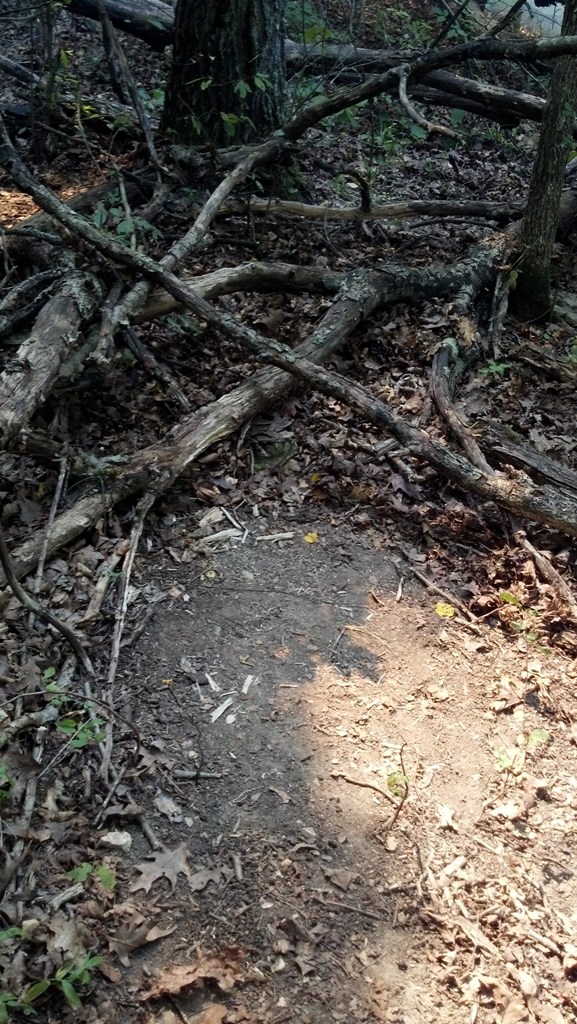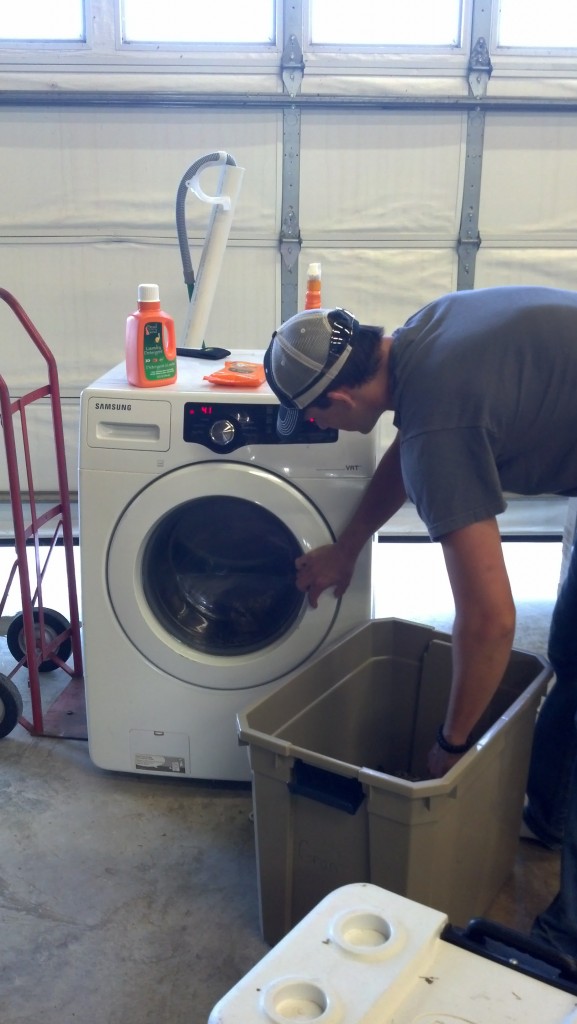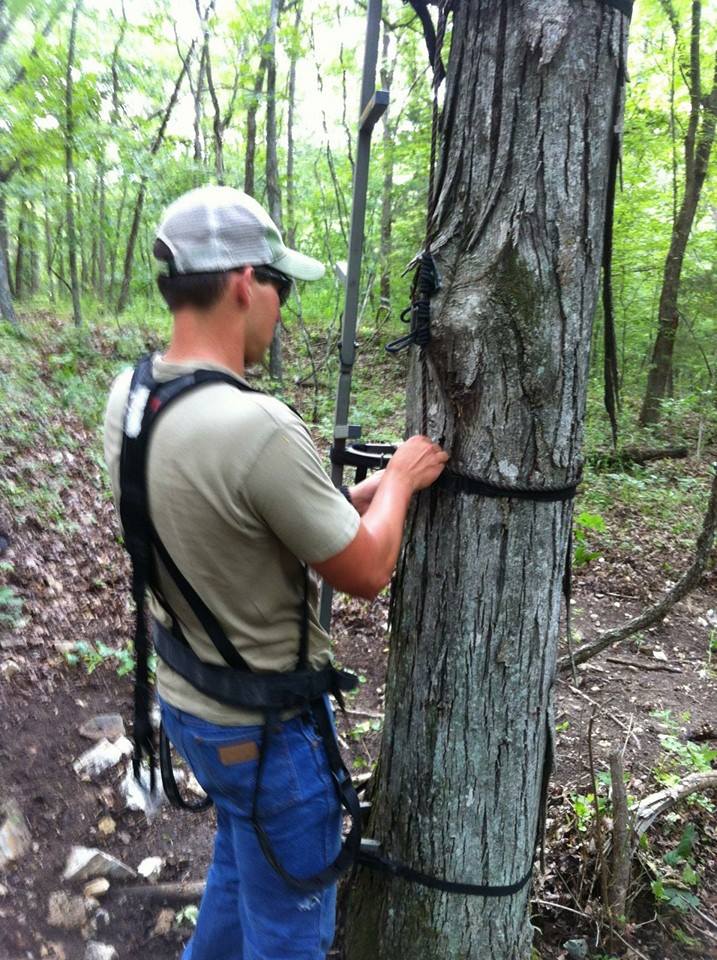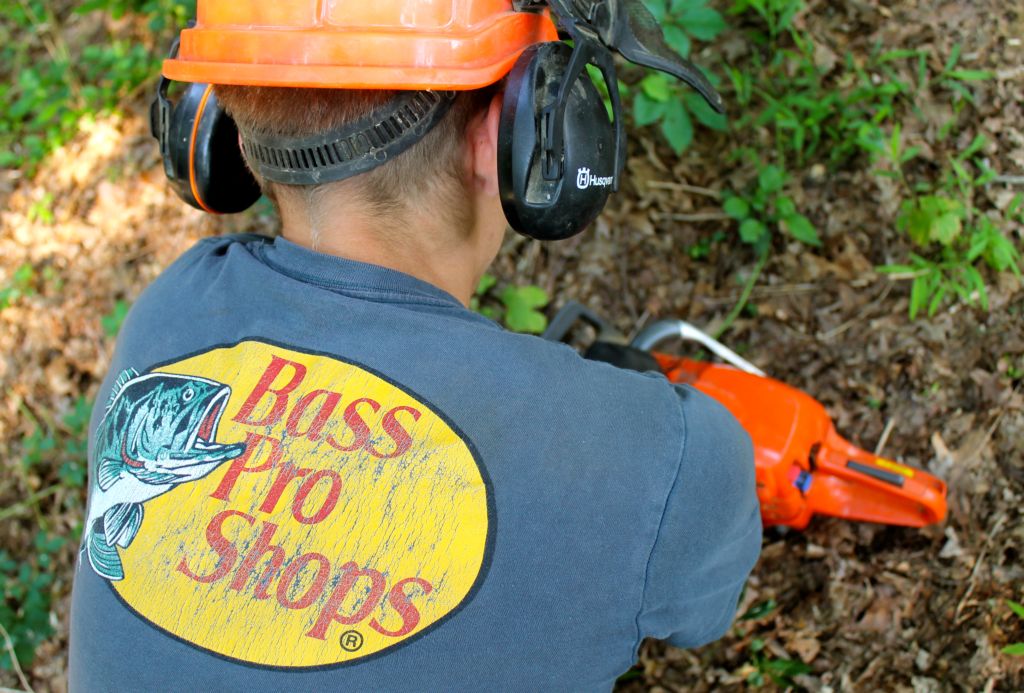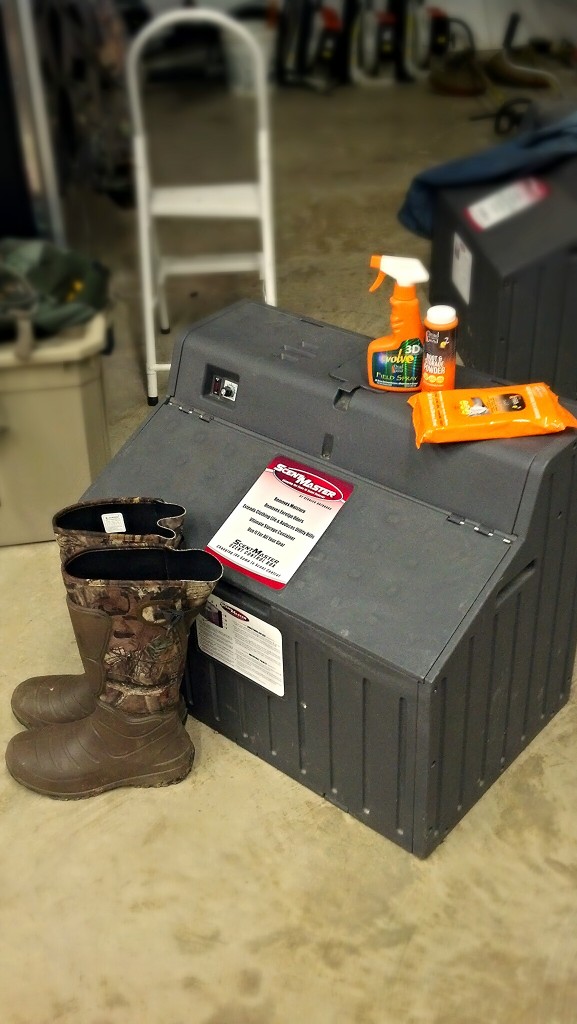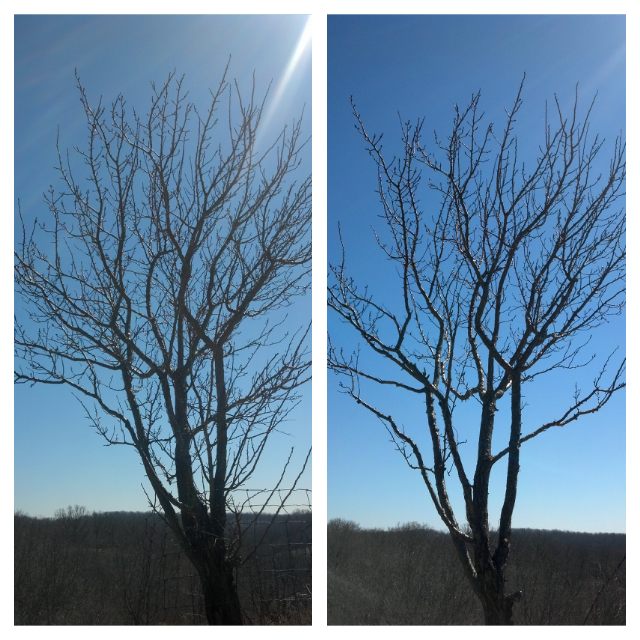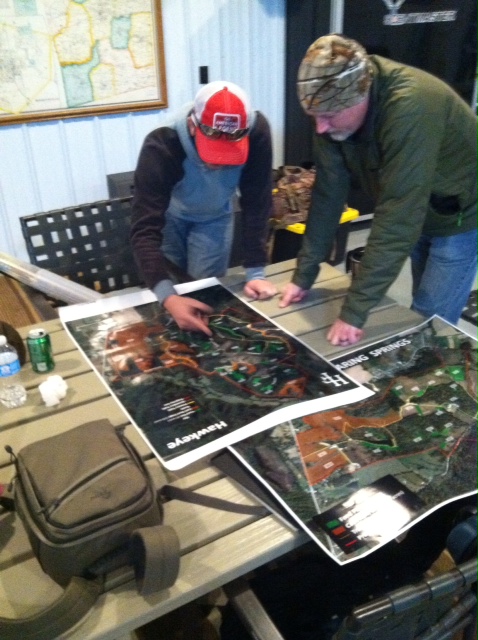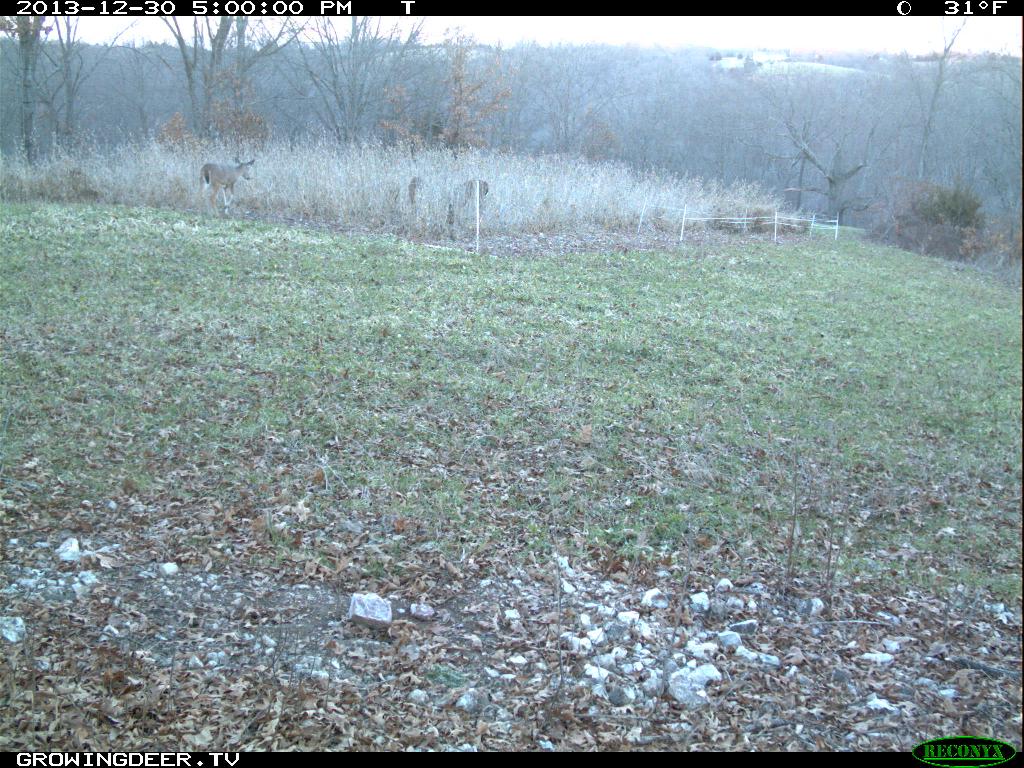Category: Hunting Tactics
Prescribed Fire Scouting
Late August can mean a couple different things for the GrowingDeer Team. If we’re receiving occasional rainfall and cooler temperatures we’re usually planting food plots. If the weather is hot and dry we’re headed out with drip torches in hand to practice some prescribed fire! I enjoy this management tool, but something I enjoy more than prescribed fire is scouting the terrain and trying to understand deer. This is where these two practices go hand in hand.
Prescribed fires here at The Proving Grounds usually consist of lots and lots of walking. We’re hiking up and down ridges, through valleys, over mountains, and back again. This is a great time for us to not only find bottlenecks and saddles on the ridges, but even more important, to find specific bedding areas that we might not have know existed. That’s exactly what I did earlier this week on one of our fires. While walking parallel down a north slope of a ridge I came upon a small ravine, or pocket. This “pocket” was a slight bowl-shaped spot in the middle of the slope where several trees had fallen over the years.
It was a mess to walk through, but then I noticed something. Located near the center of all the trees were several deer beds. These were not your typical smashed leaves where a deer had bedded one day and left. These beds were all dirt with no leaf material in them. This told me that these beds were being used on a more regular basis than most deer beds we find. Why this spot? Why would a deer be bedding here so much? I started to wonder more and more about this spot when I looked up and noticed the smoke from a fire just down the ridge. Most of the smoke from the fire was going up into the air and being carried away, but in the pocket the air was calm, still, and most importantly, swirling. Bingo, with the surrounding treetops serving as cover from intruders the small drop in the ridge also meant that the wind swirled and was unstable for most of the day. This was an ideal location for deer to bed down, feel safe, and survive!
I’m excited to know the location of this bedding area for the upcoming fall for a couple reasons. Butterbean, a hit list buck, has been very active on our Reconyx camera just down the ridge. Even better, we have a Muddy stand setup on both sides of this pocket in the ridge! Stay tuned to GrowingDeer.tv to see if we can capitalize on this new find!
Daydreaming of whitetails,
Adam
The Countdown To Hunting Season Continues
Here we are in the middle of August and our deer season is less than a month away. On September 5th Grant and I will be packing our bags and rolling east to Kentucky for the opener on September 6th. We’re pumped about it! We’ve been excited about deer season since turkey season ended last spring! There has been a lot of preparation for the upcoming season: shooting our Prime bows, hanging and trimming our Muddy stands, and organizing our gear. There is still one more step that should never be overlooked – scent control.
Scent control is a huge topic among hunters today. You’re opening up a can of worms when you bring up scent control techniques among a large group of hunters. As for the GrowingDeer.tv team, we believe wholeheartedly in scent control techniques, especially given the terrain we hunt in. The Ozark Mountains can be a tough place to hunt when trying to understand wind direction, thermals that rise and fall throughout the day and routine wind direction changes. That’s why it’s super important for us to give ourselves every advantage we can get when it comes to trying to harvest mature bucks. The preparation that goes into this doesn’t start the week of season. We are preparing for deer season all year round. Once season is finished we wash, dry and then store our clothing and gear in the ScentMaster Boxes. When deer season begins to come around again, we’ll drag out our clothing to be washed again. This helps control any scent that may have been absorbed while in storage. By hunting the wind correctly, using the complete system of Dead Down Wind products, and storing our gear in ScentMaster Boxes we have stepped up our game in scent control.
There are many skeptics in scent control, but there is only one question that needs to be asked to those skeptics. If scent control products (when used correctly) increase your success rate ever so slightly, why wouldn’t you want that advantage? “Ever so slightly” is in no way what Grant and I believe. After several years of using the system we believe that scent control plays a huge factor in our success rate.
Always remember that deer season preparation is year round!
Daydreaming of whitetails,
Adam
How To Hunt A New Property
Obtaining a new piece of hunting land can be one of the most exciting things for a hunter! There can be something said about hunting a new area with new bucks, new stands, and an entirely new look, but there is also a great deal of concern that goes with this.
Starting with a clean slate can be an awesome experience for any hunter, but the first time you step on that property it can be exciting and downright overwhelming. You are probably thinking “Where do I even begin? I have no idea where or what the deer are doing.” This is one of the most important times for that property. By choosing to be aggressive you can alter the travel patterns and the very demeanor of the deer.
That’s why when I start out on a fresh piece of property I always tread lightly. I never want to begin the search for stand locations by finding the thickest, nastiest area and deciding to hang my stands there. Chances are, that big buck could be living close by and I may bump him out and ruin any chance of killing him that year. When selecting my first few stands to hunt, I usually set up in more of an observation view. I’ll hang back 75 to 200 yards, depending on the terrain and visibility, and observe the deer movements. Once I’ve gotten a good feel for their travel pattern, I’ll find a tree to hang in close to those trails and I’ll move in for the kill.
Another important part of selecting my stand locations is hanging a stand for every wind. I always do this step to ensure I will have a place to hunt no matter what the wind direction is! I made the mistake in my younger days of hanging five stands and all but one could only be hunted on a north wind. Bad move! These days I enter a new property so cautiously that I alert very few deer and ultimately see and harvest more deer.
Daydreaming of whitetails,
Adam
Deer Stand Locations: Ambush Strategies
I recently read a report by the University of Michigan’s Museum of Anthropological Archeology about an interesting find at the bottom of Lake Huron. A research team discovered a network of structures that they suggest are hunting blinds and funneling structures left behind by caribou hunters. Their findings indicate that the ancient hunters had built rock structures to funnel caribou past ambush points.
Reading this struck me in a pretty cool way. Not only had I been working on a new Redneck Blind location that day, but I was also making plans to enhance the natural funnel to that particular blind. Apparently some hunting techniques never go out of style! I observed deer at this location last year and noted that there are two main routes the deer take past the location of that blind. One is at twenty and the other is at sixty yards. By strategically felling a couple of trees on the sixty-yard trail, I hope to increase the percentage of deer that pass the blind on the twenty-yard trail.
I always try to learn from observations and often move stands according to patterns I observe. However, there are some situations when it is easier to bring the deer closer to me, than it is for me to sit closer to them; this is where the chainsaw comes in. By felling or hinge cutting trees in a way that persuades deer to move around them, I have enhanced many stand locations. Deer often choose the path of least resistance and I prefer that path to be in prime range of my bow.
The next time you are in the stand, remember it is important to record deer encounters while hunting. That information can be very useful in developing your own ambush strategies for use in future hunts!
Happy trails,
Hunter
Deer Hunters Need Scent Control Throughout The Year
For a lot of hunters, scent control is only practiced during hunting season and a few weeks before season. True scent control for deer hunters should be a year round activity. Unfortunately for most of us, we only have one set of hunting gear that we use for all types of hunting – coyote, deer, turkeys, etc. With each style of hunting there are different areas of concern regarding scent control. There are the hot days of spring when hunters walk through the hills chasing turkeys, all while working up a sweat. There are the damp cold days in November sitting in our Muddy tree stands waiting on a rut crazed buck. Even the snow covered days in January calling in coyotes. All of these hunts bring moisture and ultimately odor to one key area of your hunting gear – boots.
The boots you wear to your tree stand are one of the most likely pieces of your gear to spook game due to their smell. You sweat in them, you walk through mud puddles in them, and you walk through creeks with them, every step you take while hunting is in your boots. That’s why it’s extremely important to take care of your boots and maintain proper scent control. I believe every pair of boots has an “odor life.” Of course when you buy your boots they have a “new” scent to them. Once that odor is removed and they’ve been properly taken care of, they now enter into the “boot life.” If boots are taken care of properly they can last several hunting seasons, but there are numerous things to avoid. Not wearing them in gas stations, walking through the mall, hiking, anything that clogs them with foreign odors is key. Keeping them clean, dry and stored before each hunt is the best way to increase their life.
We treat boots after every single hunt with Dead Down Wind foot powder. This powder absorbs the moisture and destroys the odor, making sure the next time out our boots are as odor free as we can get them. Next we’ll spray the outside of our boots with Dead Down Wind field spray. This destroys any odor on the outside of our boots that may have collected during the hunt. Then we place them in our ScentMaster Box and turn it on, making sure as much odor as possible is removed from our boots. The box will heat up to 130 degrees, removing any moisture remaining in the boot and also filtering out any other odors that might have been missed. This system not only controls a huge part of our odor but it also greatly increases the life of our boots!
Don’t postpone your scent control this summer just because deer season is months away. Fight the odor now and tag your buck this fall!
Day dreaming of whitetails,
Adam
Using Science To Pick Which Stand To Hunt
Last week I shared the results of some recent research from the University of Georgia. Those researchers found deer opted to spend more time inside a 105 acre area where coyotes were excluded by a fence, compared to similar areas just outside the fence.
Clearly, deer preferred feeding, etc., in areas they believed to have less danger. Do deer consider hunters predators – and avoid areas they associate with hunters? Click Here To Read More at Winchester.com
Fruit Tree Plots: Key For Early Season Whitetails
Across much of the whitetails’ range deer managers plant fruit tree plots. Fresh fruit is very attractive to deer and can be the key to tagging an early season bruiser. Just like any other food plot, fruit trees require care.
Fruit trees require pruning each year. Proper pruning allows fruit trees to produce more and better tasting fruit. It is important to wait as late into the dormant season as possible before pruning. The GrowingDeer team likes to watch the weather to ensure a warm day follows the day of pruning. A warm day allows the tree a day of growth to cover the wounds from pruning.
When pruning, cut any limbs that are not growing up at a 60-degree angle. A 60-degree angle is ideal for bearing the weight of fruit. It is also important to look for any limbs that are touching any other part of the tree. Rubbing limbs leave the tree scarred and exposed to disease. Trimming more is usually better than being conservative. Prune until there is a scaffolding like structure that allows sunlight to reach all parts of the tree.
It has been a rough winter, but hang in there – spring is close! If you are blessed with a warm sunny day take advantage by getting out there and showing those fruit trees some love.
Chasing Whitetails together,
Brian
How And When To Plan For Next Hunting Season: It Begins Now!
January 15th is a bitter sweet day for me. Why? January 15th marks the last day of archery season here in Missouri. On one hand I’m extremely upset that the season is over. We started chasing deer in the beginning of September and now, the middle of January, is when we hang up our Prime bows for a rest. That’s where the “sweet” part comes into play. After all these months it is nice to step back and take a breather and rest, charge our batteries, and clear our heads.
After we clear our heads we then start putting in thoughts and ideas for the upcoming season. Yes, you heard me correct. It’s January 17th and we’re already thinking about next deer season! Great management plans aren’t drawn up and executed in a matter of a few months – that’s why we’re starting now. Obviously we’ve been doing management projects throughout the season but we’ve postponed the projects that will add more disturbance to the property. Now with this season complete it’s time to start back up!
Like most years we start by looking at our map. Where are our stands located? Where is the food located? Where are the bedding, bottlenecks, and water sources located? Finally, how can we hunt the property more successfully? One of our biggest projects for this year is dealing with the southern part of The Proving Grounds. This part hasn’t been as highly managed and has very few food sources and stand locations. Our plan is to provide both of those and bring it all to you in coming months, stay tuned to GrowingDeer.tv!
Other goals we are looking forward to completing are clover maintenance and additions, invasive species control, and prescribed fire.
First we’ll talk clover. We manage about 10% of our food plots in clover. Every year we’ll watch it progress or decline and study which areas need to be replanted and which plots are being used heavily and could possibly be hunted more regularly.
Invasive species control can bore most people, including myself, but it’s part of good management. Over the last couple of years we’ve tackled a huge infestation of honey locust trees but I’m happy to say we’ve knocked about 90% of the population out and we’re now searching the hillsides for any squatters that may still be surviving. This next year we’ll be shifting our focus to multi-floral rose bushes. They’ve begun to spread into the food plot edges so it’s important for us to eliminate the problem before they start to gain ground and compete with the food sources we’ve planted.
Lastly, one of our biggest and most time consuming projects, prescribed fires. We spend a lot of time working for fire, it all starts by making the fire line to finishing it with the lighting of the fire. This is a huge project but when it’s all said and done the benefits are huge! Be sure to check out our progress throughout the off season!
But – we’re not completely locked up inside! Cabin fever is real ya know! We’re going to be doing a little predator hunting to see if we can’t have a little fun and deal with the depression of deer season closing.
Daydreaming of whitetails,
Adam
Sign in the Snow
Most hunters, myself included, don’t hunt where snow cover is common throughout the deer season. When it does snow, it’s a great opportunity to scout! Every deer track, trail, fresh scrape, feeding area, and bed will be easy to find! Read More At Winchester.com
2013 Preparations For 2014 Results!
We have turned the page of 2013 and as we enter 2014 we’re still looking to have payoffs from last year’s work!
A lot of the loyal GrowingDeer.tv followers have watched the progress of our Non-Typical Hot Zone electric fence throughout the summer, fall, and now the beginning weeks of winter. The entire plan all began back in May when we started planting our food plots in Eagle Seed beans. We selected this plot we call “Lil Cave” back in the spring as being a great location to leave some grain for the late season. This particular food plot is located on a ridge top and is relatively small, especially compared to the large food plot less than 300 yards away. Because of the plot’s small size we used our Hot Zone fence to protect it throughout the growing season, and into the fall, and now winter. By allowing these Eagle Seed beans to grow without the heavy browse of wildlife, they reached shoulder height and are completely covered with bean pods.
Although The Proving Grounds was completely covered with acorns this year, we received an early snowfall which caused our deer to start using our food plots sooner than we expected. When the snow fell and deer became more and more active on the food plots we decided it was time to open a portion of the fence and allow the deer to feed on the beans. Like a lot of things dealing with wildlife, there’s a learning curve (from days to weeks) from opening the gap to when deer learn of it’s safety and value. While checking our Reconyx cameras last week we noticed the deer were really starting to enter the gap and consume the beans, even during daylight hours, GREAT NEWS!
Now with just a couple weeks of season left, we can’t wait to climb into the Muddy stands overlooking the Eagle Seed beans in hopes of harvesting a mature buck or even a couple of does! Be sure to check out upcoming episodes of GrowingDeer.tv to see how our plan works! Good luck to everyone as we roll into the New Year and may God bless you in your pursuit!
Daydreaming of whitetails,
Adam



